In South Texas, every ocelot counts. Losing even one can have grave repercussions for the species’ future.
The small, spotted cat – twice the size of your standard house cat – faces a precarious existence as it navigates ever-dwindling habitat, roads and a border fence.
The ocelot population here is, at best, in the dozens. Can they really survive?
That’s what I’m here to find out, spending time with U.S. Fish and Wildlife Service biologists working on public land and Nature Conservancy scientists working on private land. Together, their research and conservation efforts offer the best hope for the elusive cat along the border.
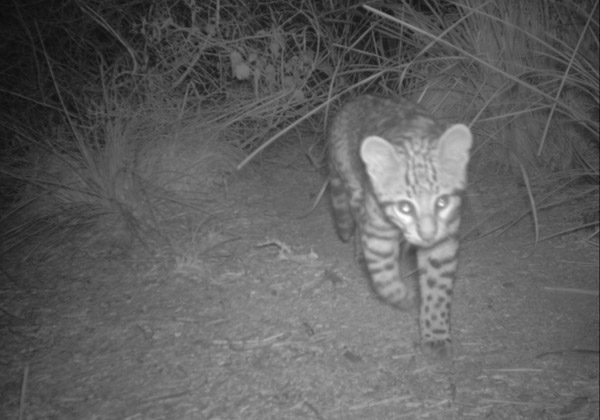
“A Fight with a Box of Thumb Tacks”
Hilary Swarts bursts from her office, a big smile on her face and radiating energy. She runs the ocelot research program for the U.S. Fish and Wildlife Service at Laguna Atascosa National Wildlife Refuge, a South Texas refuge that is a stronghold for the cats.
Today, she’s going to show me prime ocelot habitat and the refuge’s extensive research and monitoring program. “I just love to think about these cats,” she says. “Some days I can’t believe this is my job.”
She looks too young for her resume – she’s studied monkeys in Belize and Suriname, gorillas in Rwanda, island foxes on the Channel Islands. But this is perhaps a more vexing challenge.
In fact, despite her happy demeanor, I later learn she has been managing a bit of a crisis.
The radio collar of one of the refuge’s ocelots has been emitting a “mortality signal” – a steady beep that means the collar is not moving. And it hasn’t been moving for 8 hours.
It could mean the ocelot has merely lost the collar. Or it could mean it is dead.
She apologizes that she’ll have to be checking her cell phone throughout the day to see if this ocelot has been killed, as assistants track down the collar in the brush by homing in on the signal.
The assistants are experienced in ocelot tracking, but Swarts is clear. If the assistants run into any problems, she’ll have to leave my tour. Ocelots come first.
It is a young female – one of a pair of one-year-old ocelots confirmed on the refuge this year, the first evidence of successful breeding in several years.
Every ocelot counts. If this one is dead, it would be a huge blow.
Every ocelot counts. If this one is dead, it would be a huge blow.
But in some ways, Swarts is used to dealing with bad news. The ocelot, after all, is clinging to a precarious existence here.
Ocelots are more commonly associated with tropical forest environments – the Amazon, for instance. But they once ranged as far north as Arkansas.
In the northern part of their range, ocelots thrive in thornscrub – the thick, dense forest cover that once dominated much of South Texas. The problem is, not much of that habitat is left.
Brush is pretty much incompatible with human use. Even conservationists acknowledge that it takes a lot of effort to find a human value for it. You can’t live there, you can’t farm there, you can’t drill in it.
But for ocelots? Ocelots love the thick stuff.
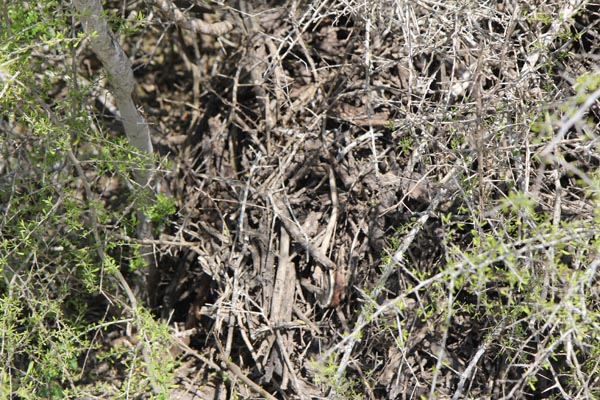
Swarts drives me to a prime patch of brush cover, an “ocelot crossing” sign signifying we’re entering the cat’s realm. I try to peer into the habitat and see…not much. It seems impenetrable, as if a mouse might not be able to move without getting hopelessly tangled. Thorns cover everything.
“It’s ugly getting through that stuff when we have to retrieve a radio collar or a camera trap,” says Swarts. “Walking through that is like getting in a fight with a box of thumb tacks.”
I imagine an ocelot’s beautiful, glossy pelt being torn to shreds. Swarts sets me straight.
“It will blow your mind to see them going through this,” she says. “We have sequences of camera trap images. They’re small and flexible and they move through it gracefully. It is worth it for them to live there. In the thornscrub, they’re safe.”
While the U.S. Fish & Wildlife Service, the Conservancy and other groups are actively restoring the habitat, it can take years for the brush to be fully established. Throughout much of the area, there are fragments of habitat often far apart from each other.
When ocelots move, they enter the fast-changing human realm of South Texas – a world of roads and speeding cars and tall fences.
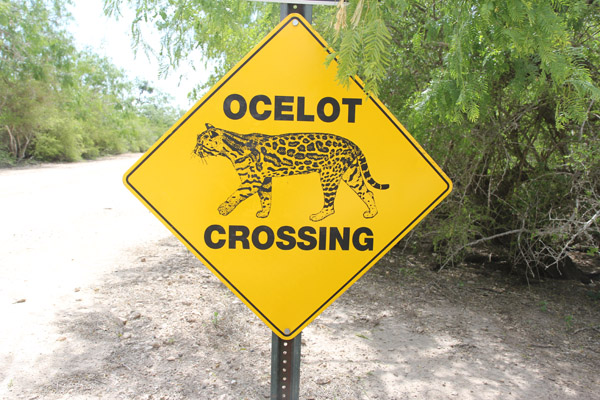
On the Road, Again
The Rio Grande Valley is known among birders and other naturalists for its spectacular protected areas – three national wildlife refuges, state parks and private preserves. The areas hold spectacular numbers and variety of wildlife.
But many of these areas are not connected – and what fills the space between has largely been developed. The valley has a growing population, currently at 1.2 million people. This many people cause a number of threats to ocelots, but the biggest is roads.
“If land is undisturbed, ocelots will use it,” says Robert Jess, Senior Refuge Manager of the South Texas Refuge Complex. “The problem is, a lot of that undisturbed land is disconnected. To get from one place to another, ocelots have to cross roads. And vehicle traffic is just plain horrible on cats.”
Swarts drives me along a scenic route – the type of wildlife viewing loop common on national wildlife refuges. She stops along one stretch of bumpy habitat, and points to the road. A lactating female was killed there in 2009. A male was killed on a nearby state highway last November.
It’s why she’s so concerned about the mortality signal on the radio collar. To lose one of the young ocelots on the refuge would be perhaps an even bigger blow after November’s death. A young female has the potential to contribute to population growth by breeding and raising kittens.
Swarts remains hopeful. The Texas Department of Transportation, she says, is taking a cooperative role in examining how roads can be more wildlife friendly. They’re currently implementing plans for wildlife crossings on a road improvement project adjacent to the refuge and removing sections of concrete barriers on the busy highway south of the refuge where the male ocelot was killed in November.
A refuge support group, the Friends of Laguna Atascosa National Wildlife Refuge, recently worked with state agencies to create a specialty license plate to support ocelot conservation in Texas. Awareness and support are growing.

Still, ocelots face other challenges. One of the new ones is the Border Fence, the 30-foot-high division between the United States and Mexico recently completed.
I’ve spent several days driving around the border towns, and encounter no shortage of strong opinions on the fence. Emotions are running high, as recent news reports from this very area indicate. Many express skepticism at how well it is performing its intended purpose.
But most conservationists agree that it is very effective at stopping wildlife movements.
There’s a lack of research, in no small part because most environmental laws were suspended to construct the fence. That means that environmental impact studies weren’t conducted. But it clearly has the potential to cut off pathways used by wide-roaming animals like ocelots.
“All refuges have issues to deal with,” says Jess, who has worked on refuges across the country, from Florida to Alaska. “But the level of complexity here is just off the charts.”
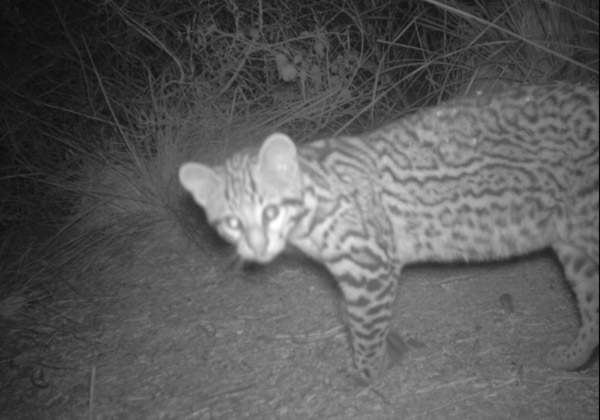
Monitoring an Elusive Cat
When a small population of animals is disconnected, part of the challenge is maintaining genetic diversity. With small ocelot populations hanging on in fragmented habitats, is this a risk?
“When the population is this low, we get afraid about the possibility of inbreeding depression,” says Swarts. “But we don’t have enough data, or even enough research subjects, to be able to say if the ocelots are showing signs of suppressed reproductive success, or disease susceptibility. We don’t have a lot of reproductive or disease data.”
And that is what she is here to rectify. Swarts is leading a continuing extensive effort to collect that data on ocelots and use that help direct land acquisition, habitat restoration and other conservation efforts.
But how to gain information on an elusive animal that spends much of its time in thick, thorny vegetation?
We first pull up to a live trap baited with a live pigeon (the ocelot’s preferred prey are birds and wood rats). The pigeon is kept in a separate compartment and isn’t harmed; in fact, Swarts is fond of these birds, kept in a spacious pen until taking their turns at decoys.
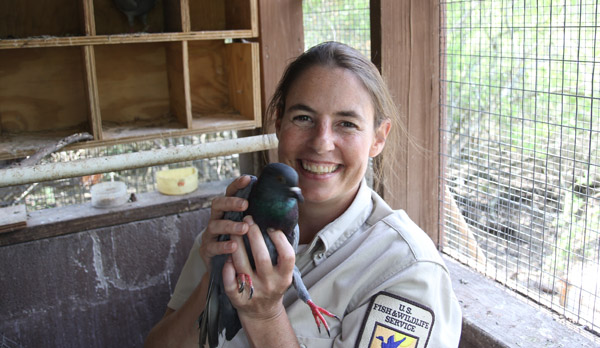
At any given time, from mid-fall to mid-spring, as many as 39 live traps are set in five areas of the refuge. When conditions are too hot, posing a health threat to the animals, trapping is suspended.
Any captured animals are radio collared and/or monitored with a GPS tracking device. This provides researchers with crucial data on their habitat use and movements.
Currently, there are four collared ocelots. Today, Swarts is hoping one of those animals isn’t dead.
Additionally, 40 to 50 camera traps are set up at likely locations around the refuge. These are often set up near “guzzlers,” permanent water sources established by the refuge to not only draw ocelots, but to help wildlife survive drought.
The camera trap images provide a picture of ocelot populations on the refuge. “Each ocelot’s spot pattern is unique, like a human fingerprint,” says Swarts. “For instance, one has a pattern that looks like a carrot. Another’s spots look like googly eyes. When we have a camera trap image, we can feel very confident in identifying individual ocelots.”
Each ocelot’s spot pattern is unique, like a human fingerprint.
Hilary Swarts
This year, camera traps verified the two young, previously unrecorded ocelots – a hopeful sign that the ocelots were breeding. When captured, Swarts verified they had a one-year-old female and one-year-old male.
The ocelot program interns were currently tracking the female ocelot’s collar to see its fate. Losing one now would mean the loss of a future breeding animal, important to the species. It would be the loss of data for the research effort.
And it would be the loss of an animal that ignited hope among conservationists and the public at large.
After our tour, Swarts excuses herself. She has to go see for herself. See if today would bring more bad news.
Hours later, I receive a text: “The interns retrieved the little girl’s collar. Just the collar. So all is well in Ocelot Land.”
The ocelot had merely lost the collar on that thicky, thorny brush.
All is well. For now. But what does the future hold?
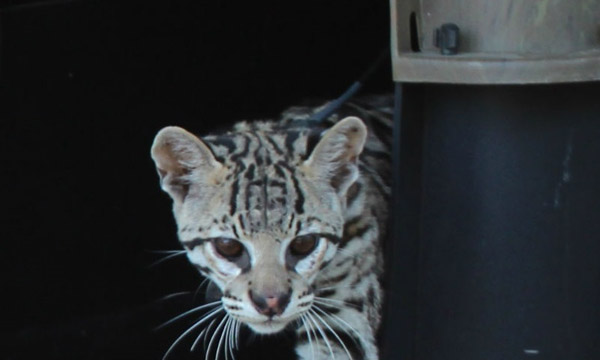



Hoping that the nature conservancy will not fight the border enforcement that we must have to ensure our countries continued freedom
Thanks
Keep up the great work. These small cats are a beautiful part of nature that needs to be protected at all costs.
thanks
I am saddened by the border fence for animal migration. Ocelot in Texas and 1 or 2 male jaguars in AZ.
Thank you for all you do to preserve our natural habitats and our precious wildlife.
Since the ocelots are small cats, could 1-2 slats at ground level be partially removed to allow the cats to go through? The holes could be disguised with permanent man-made brush, brambles could be planted on each side of the fence, use PVC for trails under the fence, or pour cement culverts to go under the fences. Get the engineers to design small swinging doors every few feet in the fence. Research the problem and save the ocelots!
Thank you!